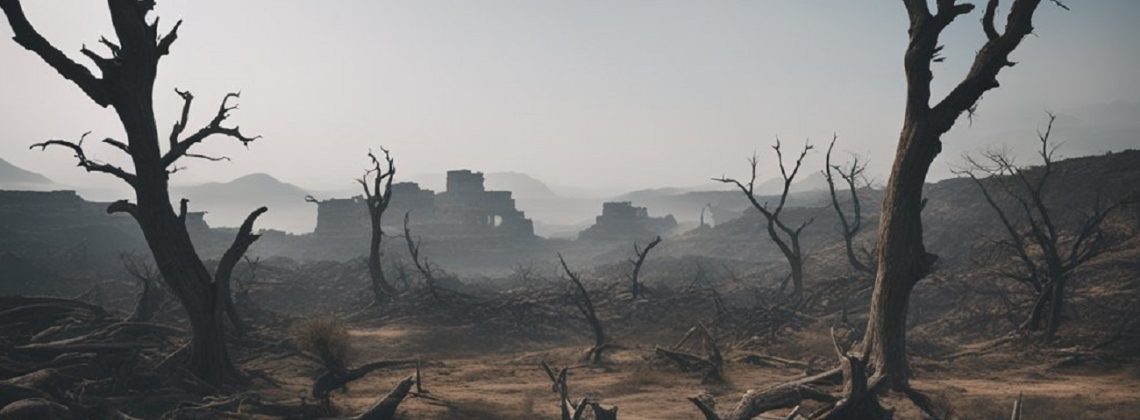
Disaster preparedness is a topic of ever-increasing importance as both natural and man-made events continue to present challenges to safety and stability. As a prepper, your goal is to be ready for a variety of emergencies which could include natural disasters like earthquakes and hurricanes, societal disruptions such as civil unrest, and global pandemics similar to COVID-19. Preparing effectively means having the knowledge and supplies to handle situations that disrupt normal life, potentially for extended periods.
While the idea of prepping might seem daunting, focusing on the essentials of survival can guide you through the process. Essentials include water and food supplies, shelter and clothing appropriate to your environment, sources of light and heat, and emergency response skills, including first aid. Equally important are strategies for evacuation, communication, and staying informed. Amidst financial concerns, learning prepping on a budget and developing homesteading skills for self-sufficiency are practical ways to build resilience.
Key Takeaways
- Being a prepper involves preparing for a wide array of emergencies, focusing on essential survival needs.
- Key aspects of readiness include food, water, shelter, and essential survival skills.
- Adopting a practical approach to disaster preparedness can make the process manageable, even on a budget.
Understanding Disaster Preparedness
When you think about disaster preparedness, it’s essentially about equipping yourself with the knowledge, skills, and supplies you need to handle emergencies. This ensures that you and your loved ones can survive and maintain a level of comfort during times when regular societal structures may not be functioning.
The Importance of Prepping
Prepping isn’t about doomsday scenarios; it’s about recognizing risks and having a plan to mitigate them. Whether it’s a natural disaster like an earthquake or a power grid failure, being prepared allows you to be self-sufficient and reduces the impact these events can have on your daily life. Your preparedness plan should be grounded in thorough research and include specific steps tailored to scenarios you’re likely to face.
- Knowledge is your most crucial tool, so constantly learn and update your information.
- Develop a planning strategy that encompasses all facets of your life, from finances to health.
Basic Prepping Principles
To start prepping, embrace the core principles of knowledge and skills development, combined with strategic planning. Understand that your prepping approach should be proportional to the emergencies you’re most likely to encounter.
- Planning: Map out potential risks and prioritize your preparations accordingly.
- Skills: Invest time in training and practice, so these skills become second nature to you.
- Knowledge: Stay informed about the best practices in emergency readiness.
| Principle | Objective |
|---|---|
| Knowledge | Seek reliable information on potential disasters and keep abreast of new developments. |
| Skills | Build practical skills like first aid, food preservation, and self-defense. |
| Preparedness | Accumulate necessary supplies while ensuring they match your needs and skillsset. |
| Planning | Create a comprehensive emergency plan and regularly update it based on changing circumstances or new insights. |
The Role of the Prepper Community
You’re not in this alone. The prepper community can be a valuable resource where you share knowledge, offer mutual support, and learn from each other’s experiences. Engaging with the community can help to broaden your understanding of emergency scenarios and introduce you to varied skills and training approaches.
- Connect with local and online prepper groups to exchange planning strategies.
- Participate in training exercises with community members for diverse preparedness experiences.
Natural Disasters
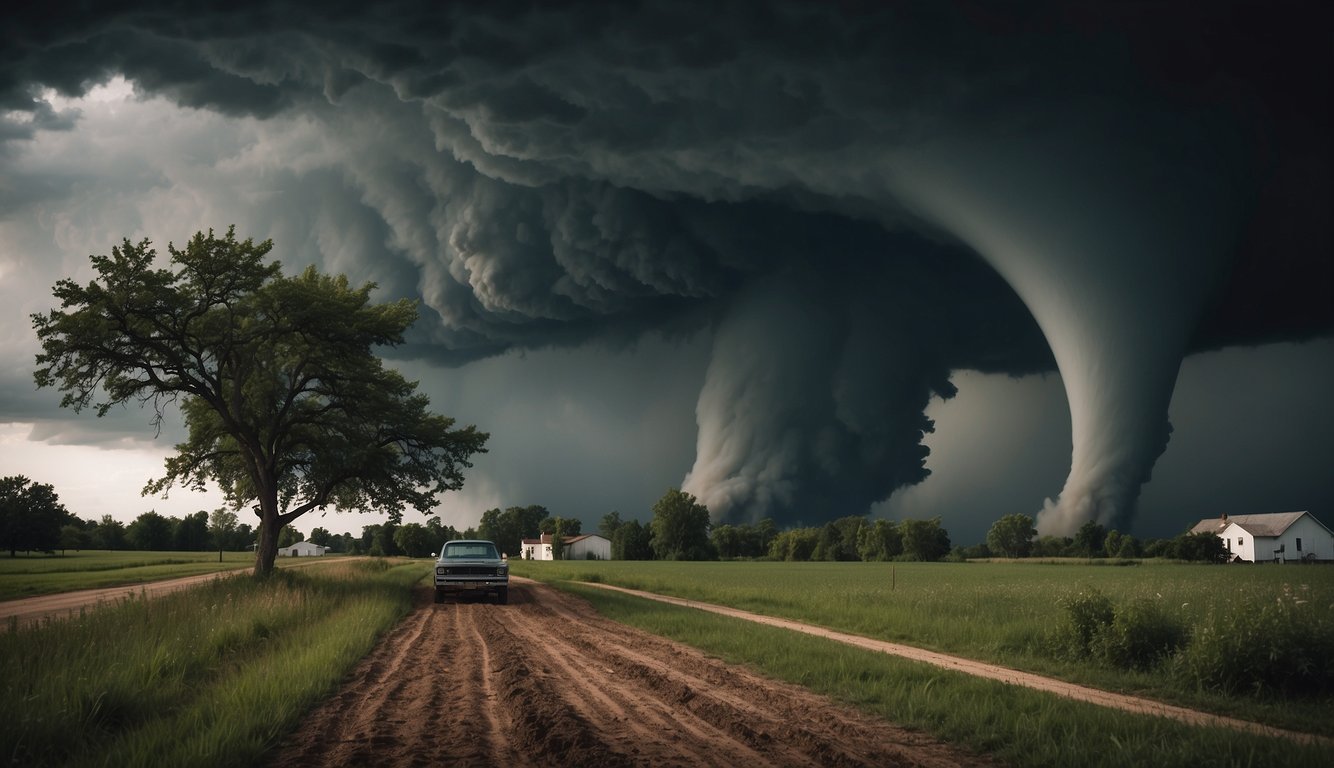
When natural disasters hit, they can be sudden and devastating, but being well-prepared can significantly mitigate their impact on your life. Here’s what you should focus on to improve your resilience against some of the most common natural disasters.
Preparing for Hurricanes
To prep for hurricanes, start by reinforcing your shelter. Windows should have storm shutters and doors need to be sturdy against strong winds. Stock up on water and non-perishable food to last at least 72 hours. A well-equipped first aid kit is essential. Be aware of evacuation routes and have a portable emergency kit ready.
Surviving Earthquakes
In earthquake-prone areas, secure heavy furniture to walls and know where your safe spots are, like under sturdy tables. An emergency kit containing first aid supplies, water, and food should be readily accessible. After the shaking stops, check for injuries and hazards like gas leaks or downed power lines before evacuating if necessary.
Dealing with Wildfires
For wildfires, create a defensible space around your home by clearing away dry vegetation. Have a fire evacuation plan, and a kit with essential supplies like water, food, and first aid. Masks for smoke, goggles, and a waterproof layer to protect from ash are crucial. Stay informed about the fire’s status and ready to evacuate if advised.
Tsunamis and Floods Readiness
If you live near coastal areas or flood zones, know the evacuation routes and have a go-bag with essentials like emergency food bars, water, and first aid. Elevate electrical components and waterproof important documents. If a tsunami alert is issued, don’t wait—move to higher ground immediately.
Economic Challenges
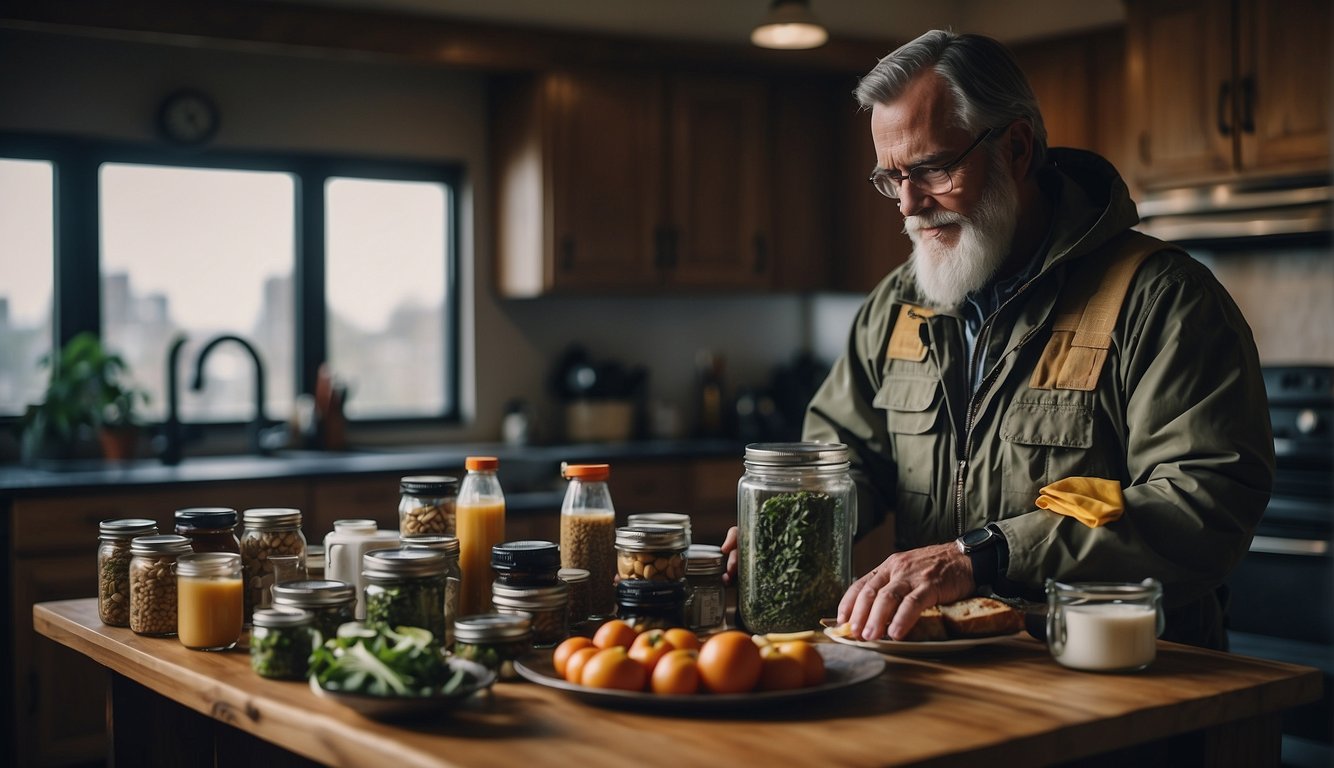
When you’re prepping, it’s crucial to consider that an economic downturn could drastically affect your ability to procure resources and manage finances.
Handling Economic Collapse
If you’re facing an economic collapse, your paper money might lose significant value. To counteract this, consider diversifying your assets. Here’s a quick look at how you can prepare:
- Stock up on Supplies: Make sure you have a sufficient stockpile of essential supplies. Think about long-term food storage and water purification methods.
- Invest in Precious Metals: Gold and silver often retain value even when currency devaluates.
- Barter Skills: Develop skills that could be valuable in a barter economy, from gardening to repair work.
Dealing with Debt and Budgeting
In tough economic times, managing your budget is essential. Take a proactive approach with these steps:
- Create a Strict Budget: Prioritize expenses to essentials and cut out unnecessary spending.
- Pay Down Debt: Focus on high-interest debt first to reduce the overall interest you’ll pay.
- Emergency Fund: If possible, save a portion of your income for a “rainy day” fund in easily accessible, stable investments.
Survival Skills and Tactics
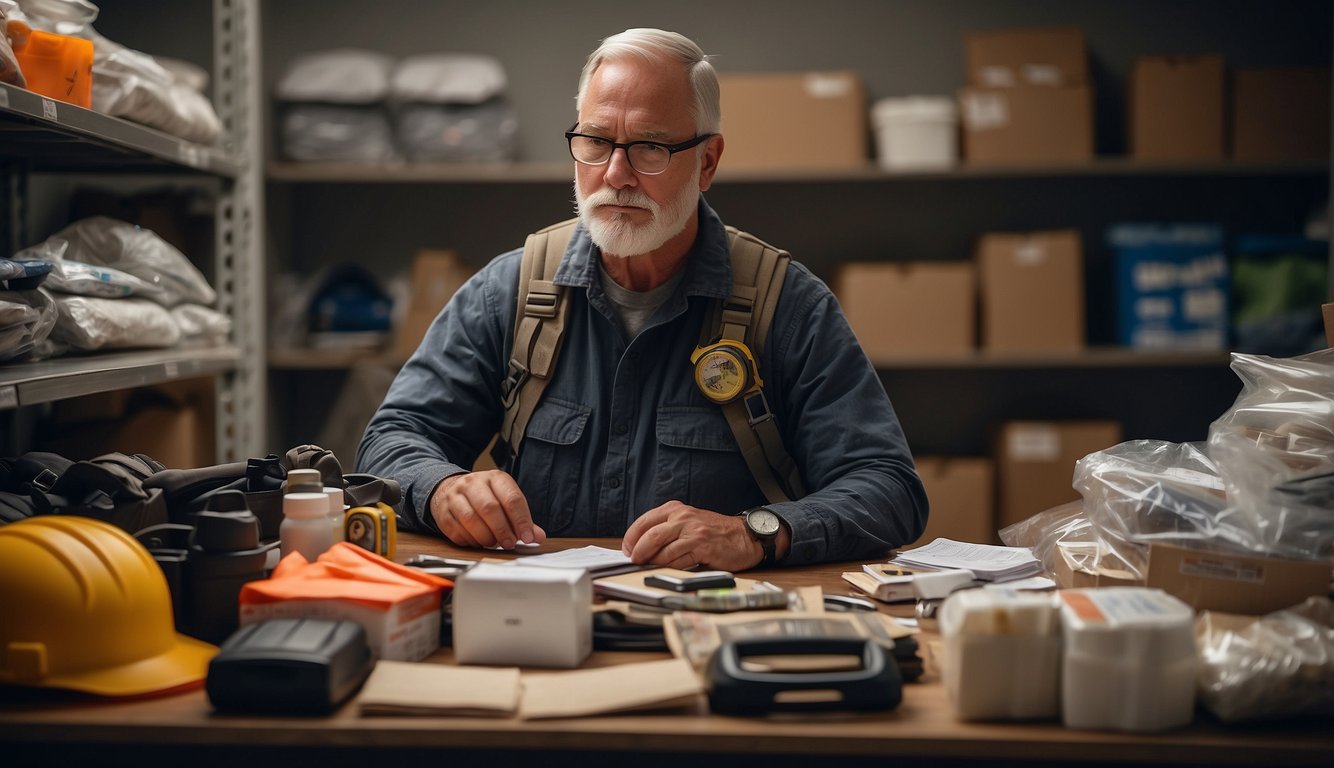
When you’re prepping for any SHTF event, it’s crucial to master certain survival skills and tactics. These aren’t just about having the right gear; they’re about knowing how to use your body and mind to stay safe, healthy, and ahead of the game.
Self-Defense and Security
Understanding self-defense is vital to your personal security in a crisis. Ensure you’re trained in hand-to-hand combat and know how to handle firearms safely if they’re part of your plan. Security measures like setting up a safe perimeter using natural elements, installing simple alarm systems, or setting traps can deter threats.
- Hand-to-Hand Combat: Join a local martial arts class focusing on practical defense moves.
- Firearm Training: Get professionally trained on handling and maintaining firearms, and always abide by local laws.
Health and Fitness for Survival
Your health and fitness are your greatest assets. A regular fitness routine that includes cardiovascular training, strength exercises, and flexibility can significantly boost your survival chances. Don’t forget to include mental health; staying calm under pressure is an invaluable skill.
- Cardiovascular Training: Run, bike, or swim to keep your heart strong.
- Strength Training: Lift weights or do bodyweight exercises to maintain muscle.
Advanced Survival Techniques
Beyond the basics, advanced survival techniques can be a game-changer. Learn skills like navigation without GPS, advanced first-aid, or how to purify water without a filter. When possible, attend survival training workshops or courses to enhance your preparedness.
- Navigation Skills: Practice using a compass and reading topographical maps.
- Emergency First-Aid: Take a course in wilderness first-aid or EMT certification for in-depth knowledge.
Emergency Situations
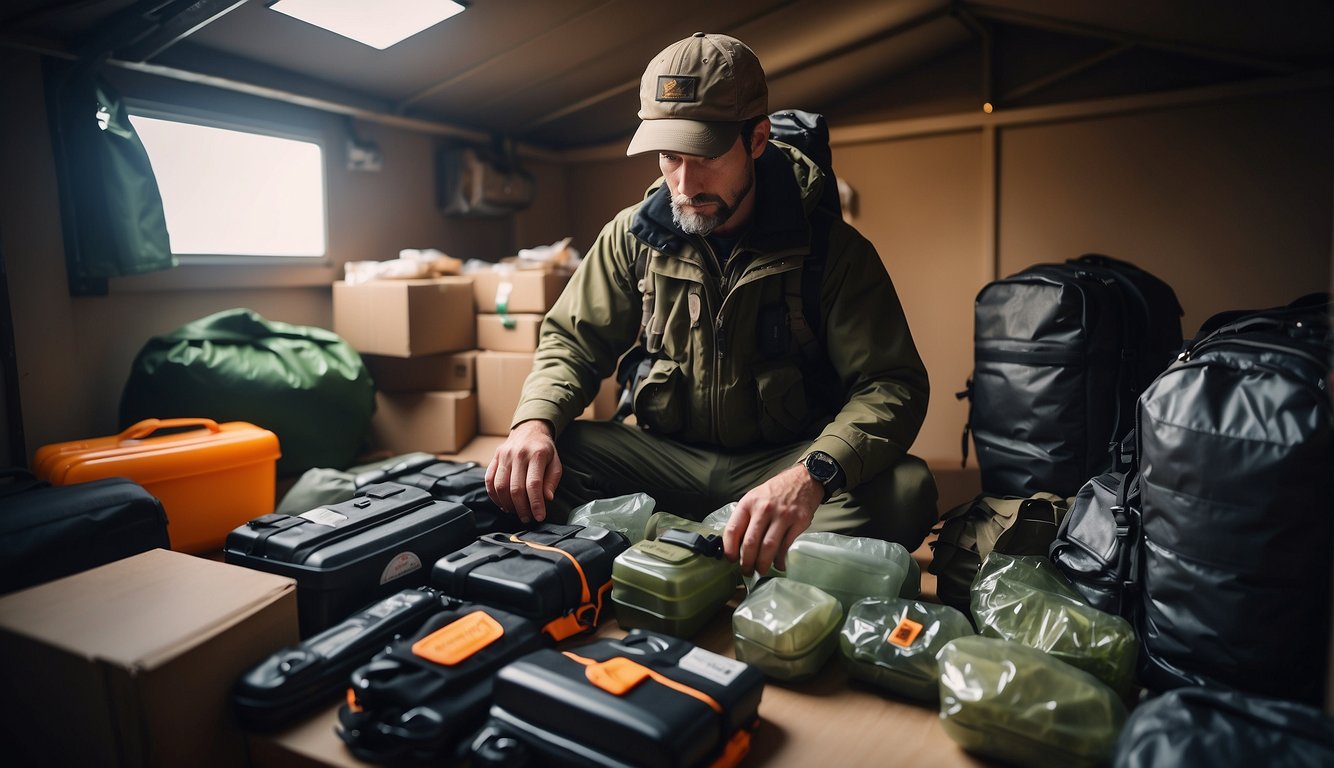
When SHTF, being prepared for a range of emergencies can make all the difference. Here’s how you tackle some specific crises like war, attacks, medical emergencies, and civil unrest.
Preparing for War and Attacks
You never know when your country might be involved in a conflict or you might find yourself in the crosshairs of an attack. Your first step is to ensure security and shelter. Sturdy, well-stocked shelters can protect you from the elements and potential threats. Think about including:
- Thick walls, possibly with sandbags for added protection.
- Stockpiles of food and clean water.
- A plan for emergency communication if traditional networks fail.
Preventing and Treating Medical Emergencies
In a medical pinch, a good grasp of first aid and having the right supplies can be lifesavers. Start your prep with the basics:
- Hand sanitizer to maintain hygiene and prevent infections.
- A first aid kit with essentials such as bandages, antiseptics, and burn creams.
- Over-the-counter medications like painkillers for managing symptoms.
Regular practice of first aid procedures, like CPR, can also significantly boost your readiness.
Dealing with Civil Unrest
During times of civil unrest, maintaining your personal safety is crucial. It’s smart to have:
- A detailed evacuation route from your home to a secure location.
- Emergency contacts listed and accessible.
- Self-defense skills or means, within the realm of legality and practicality, to keep yourself safe.
Remember, the aim is to avoid confrontation and stay safe, not to engage.
SHTF Scenarios
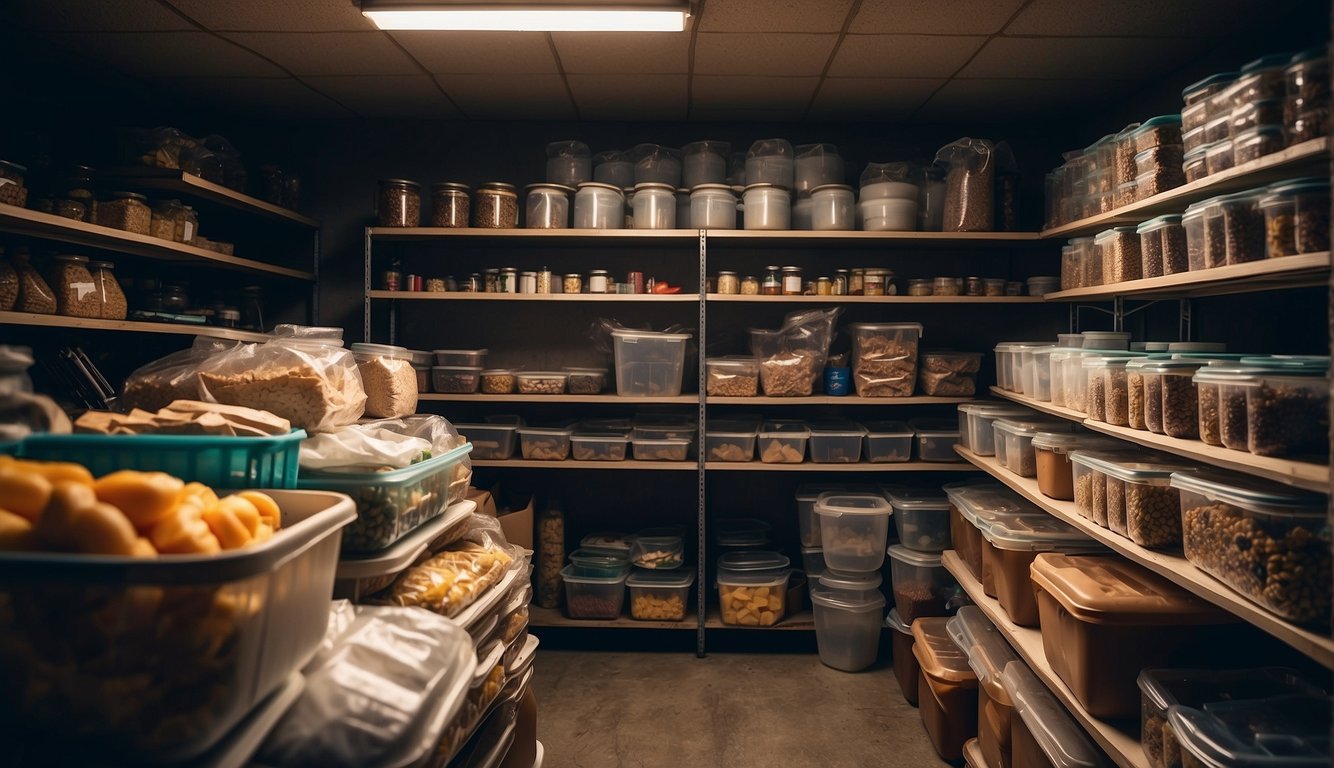
Preppers brace for various SHTF scenarios, ranging from natural disasters to man-made crises. It’s about being ready for anything that can disrupt normal life.
Understanding SHTF
Before diving into the specifics, it’s crucial for you to grasp what SHTF actually means. It represents any emergency that throws society into chaos, requiring you to either bug out or hunker down. Preparing involves understanding the risks and having plans and supplies at the ready.
Specific SHTF Scenarios
Moving from what to the how, let’s look at likely SHTF scenarios:
- Pandemic: as seen with Covid-19, diseases can disrupt global society.
- Power Outages: due to storms like Hurricane Katrina, power infrastructure can be vulnerable.
- Natural Disasters: hurricanes, floods, and tornadoes create immediate danger and long-term strife.
Here’s a brief rundown of specific events you might prepare for:
| Scenario Type | Description | Preparation Example |
|---|---|---|
| Pandemic | Widespread illness | Stockpile medical supplies, maintain good hygiene practices |
| Power Outages | Regional to national blackouts | Generators, solar chargers |
| Natural Disasters | Hurricanes, earthquakes, tornadoes | Secure shelter, have an evacuation plan, prepare a bug-out bag |
For each, your prep might differ — stocking up on food and water, planning evacuation routes, or reinforcing your home. The aim is to minimize the impact on your safety and well-being.
Preparedness Techniques
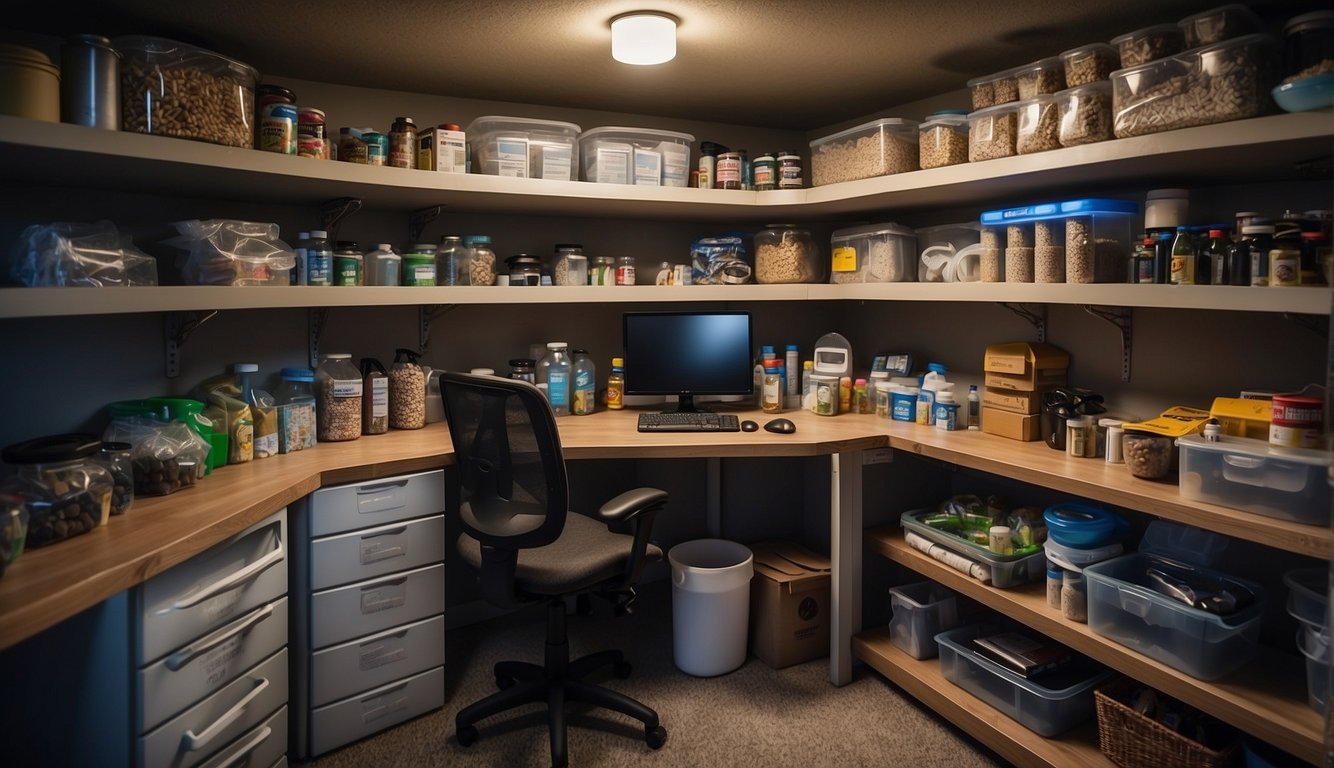
When disaster strikes, having a plan and the right resources can make a significant difference in your ability to cope and recover. Here’s how you can prepare for the worst with the right techniques and essentials.
Bug Out vs. Bugging In
Bugging out means leaving your home due to an emergency and moving to a safer location. Bugging In is when you stay put, fortifying your home against potential threats. Consider your location, the nature of the disaster, and resources when deciding which strategy is right for you.
Food and Water Storage
For food storage, focus on items that have a long shelf life and provide ample nutrition:
- Canned goods (beans, vegetables, meat)
- Dry staples (rice, pasta, lentils)
- Powdered milk and juices
Water storage is equally critical:
- Store at least one gallon of water per person per day.
- Use food-grade water storage containers.
- Consider water purification methods like filters or iodine tablets.
Tools and Equipment Essentials
Your toolkit should contain essentials for survival and repair tasks:
- Multi-tool
- Flashlights and extra batteries
- Manual can opener and cooking utensils
- Portable stove or grill
Don’t forget hygiene and sanitation products to maintain health.
Creating Your Bug Out Bag
Your bug out bag should include essentials that will last for at least 72 hours:
- Food and water: non-perishable food, water bottles, and purification tools.
- Clothing: weather-appropriate attire and sturdy footwear.
- Shelter: compact tent or space blanket.
Note that your bag should also have first aid supplies, personal documents, and anything else crucial for survival.
Prepping on a Budget
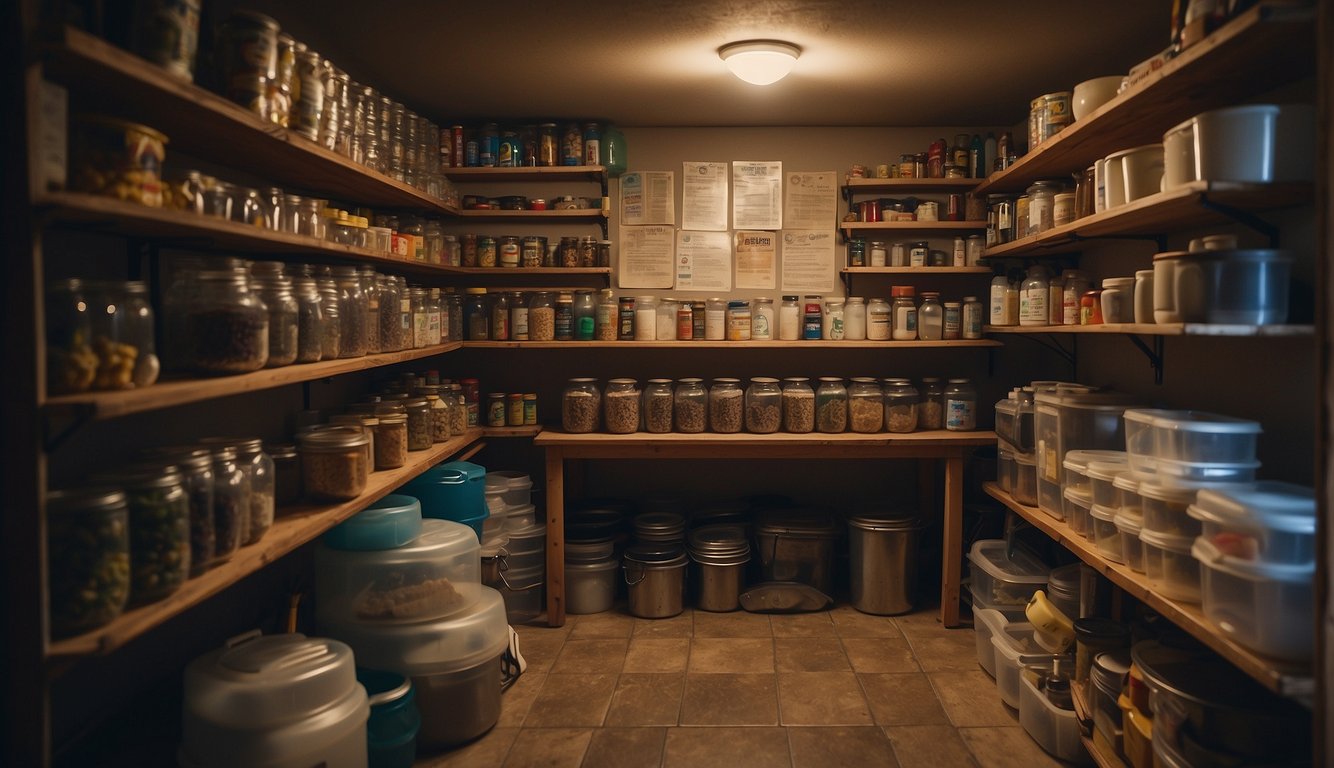
In the world of prepping, smart budgeting can be the difference between being well-prepared and feeling overwhelmed by the cost. You can effectively prep without breaking the bank by focusing on affordable strategies and creating your own supplies.
Affordable Prepping Strategies
Your budget doesn’t have to limit your preparedness. Start by prioritizing essentials such as water, food, and first aid supplies. Here’s a straightforward approach to stockpiling on a budget:
- Divide your shopping list: Separate items into more affordable and higher-priced categories.
- Buy canned goods in bulk: Canned goods are a budget-friendly staple with long shelf life.
- Allocate funds weekly: Set a portion of your weekly budget, however small, to acquire prepping supplies.
- Look for deals: Keep an eye out for sales and discounts on supplies to stretch your budget further.
By consistently dedicating a portion of your budget to prepping, you can gradually build a substantial stockpile without financial strain.
DIY Supplies and Repairs
You don’t have to purchase everything new. Get resourceful with do-it-yourself techniques:
- Utilize recycled materials: Common household items can be repurposed for prepping needs.
- Learn basic repair skills: Acquire skills to mend clothing or fix simple machinery to extend the life of your resources.
Making your own supplies or repairing what you already have can significantly limit the need for new purchases and is a cost-effective step towards self-reliance.
Homesteading and Self-Sufficiency
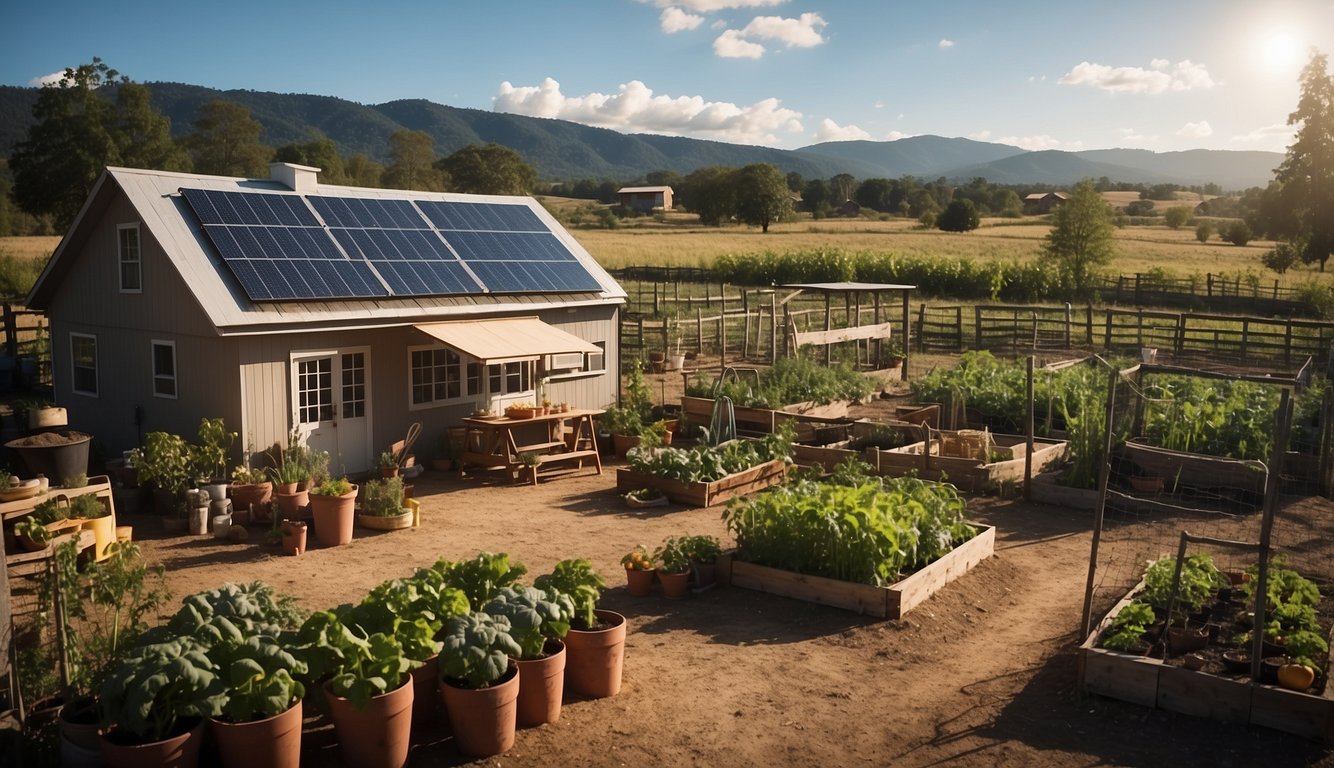
In prepping for potential disasters, you’ll find that honing your homesteading skills and striving for self-sufficiency are crucial. They empower you to maintain stability, ensuring you’ve got shelter, food, and water covered. Let’s dig into the specifics.
The Basics of Homesteading
Homesteading is your foundation for survival. It’s about using your land to sustain yourself, which means you’re going to need to know how to grow food, manage water resources, and provide shelter. Here are some key components:
- Land Management: Learn how to cultivate and harvest crops. Your goal is to create a reliable food source.
- Water Collection: Set up systems to collect and purify rainwater, ensuring you have a steady supply for drinking and irrigation.
- Shelter Building: Gain the skills to build and maintain a durable and safe living environment.
Becoming Self-Sufficient
Now, self-sufficiency is about minimizing your reliance on external systems. It’s the peace of mind that you can handle your health, nutrition, and safety needs independently. These points are central:
- Food Independence: Aim to master a variety of preservation methods such as canning, smoking, and drying.
- Medical Knowledge: Basic healthcare know-how is vital. First aid, herbal remedies, and chronic disease management can save lives.
- Skill Set: Your tool belt of survival skills should be wide-ranging – from making clothes to fixing tools.
Remember, every bit of knowledge and every skill you acquire not only prepares you for disaster but also enriches your daily life.
Gear and Supplies
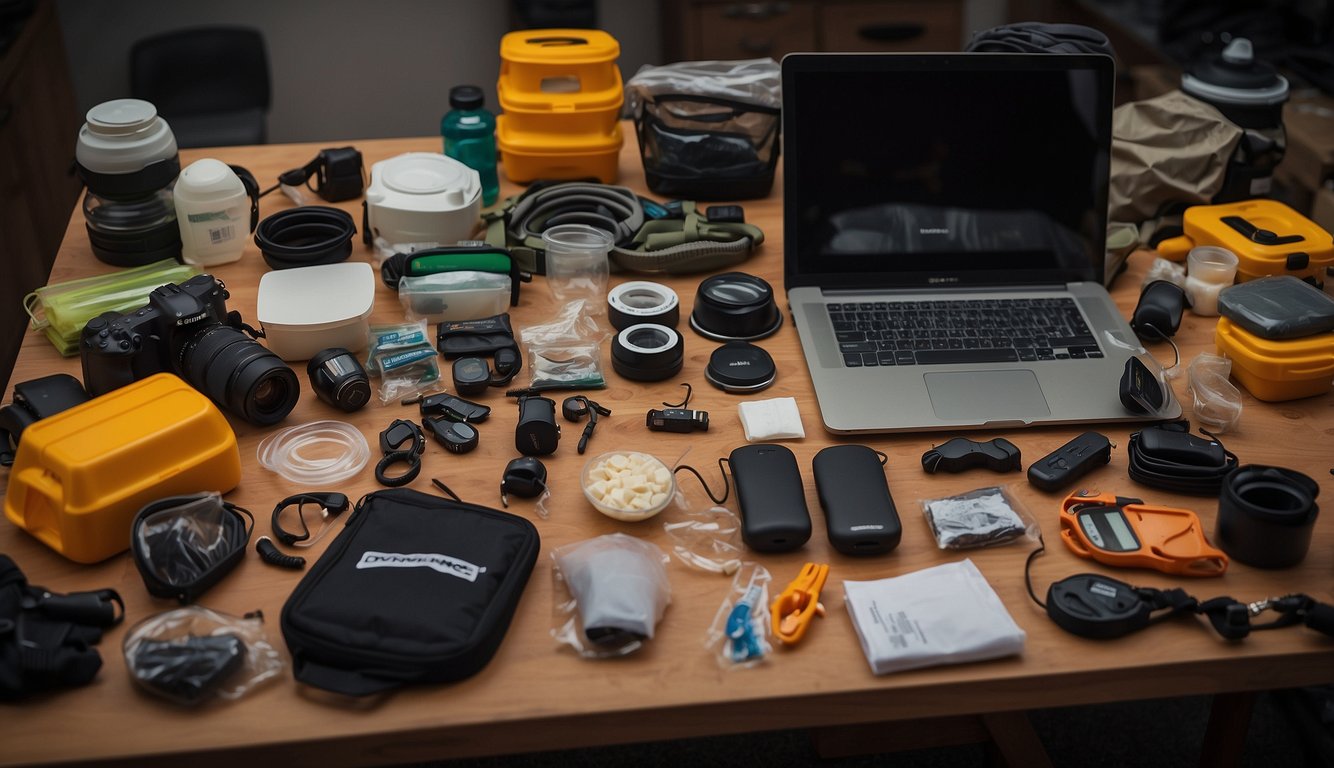
When you’re preparing for unpredictable events, your gear and supplies are your lifeline. It’s not just about having stuff—it’s about the right stuff. Think things that’ll keep you warm, fed, and safe, plus ways to get in touch with others when your phone’s no more than a fancy paperweight.
Survival Gear Must-Haves
Essentials Kit:
- Food: Non-perishables like canned goods, energy bars, and dehydrated meals.
- Water: Filters, purifiers, and containers (consider a minimum of one gallon per person per day).
- Shelter: Tents, tarps, sleeping bags rated for the climate you’re in.
- Clothing: Thermal wear, rain gear, sturdy boots.
- Tools: Multipurpose tools, knives, hatchets.
First Aid:
- Complete first aid kit with manuals.
- Extra prescription medications and over-the-counter essentials.
Navigation:
- Compass and local maps (because Google Maps won’t help if the grid’s down).
Power and Energy Sources
- Generators: Gas-powered for short-term use. Remember, they need ventilation—don’t use them indoors.
- Solar Options:
- Panels and chargers for sustainable energy when the sun’s out.
- Battery banks to store that power for a rainy day.
- Lighting:
- Flashlights and headlamps (LED are long-lasting).
- Lanterns for broader area lighting.
Communications and Information
Radios:
- Hand-crank and battery-operated for news updates.
- Ham radios for two-way communication when cell towers are kaput.
Internet Alternatives:
- Satellite phones or offline downloadable maps and resources.
Communication Plan:
- Have contact info written down and a meet-up plan for when tech fails.
Food and Water Preparations
Preparing for disasters means ensuring you have access to the essentials: food and water. You’ll need safe drinking water and a stockpile of food that remains edible without refrigeration.
Safe Water Solutions
Having a reliable source of drinking water is critical in a disaster. If your regular water supply is compromised, you’ll need alternatives:
- Bottled Water: Store at least a gallon per person per day, aiming for a 3-day supply minimum.
- Water Filters: Products like the LifeStraw can filter contaminated water, making it safe to drink.
- Disinfection: Plain bleach (unscented, without additives, about 8 drops per gallon) can purify water if boiling isn’t possible.
Shelf-Stable Food Options
Your emergency pantry should be filled with foods that don’t go bad quickly and provide ample nutrition:
- Grains: Rice and pasta are staples; they’re calorie-dense and have a long shelf life.
- Protein: Canned tuna, beef jerky, and nuts are great sources of protein and last a long time without refrigeration.
- Convenience: Consider ready-to-eat or minimal-prep required foods like canned beans or freeze-dried meals.
Cooking Without Electricity
When the power goes out, you’ll need alternative methods to prepare your food:
- Camping Stoves: Can run on various fuels and are perfect for heating meals.
- Solar Ovens: Utilize sunlight to cook or warm food, assuming you have access to a sunny spot.
- Fire: If safe to do so, cooking over an open flame is an option; just ensure you have a stockpile of wood or charcoal.
Shelter and Clothing
When prepping for disasters, having reliable shelter and appropriate clothing can make a significant difference in your survival. These elements protect you from the elements and help maintain your body’s core temperature.
Building and Securing Shelter
Your first line of defense against harsh conditions is your shelter. A sturdy tarp can be a versatile piece of equipment for creating an emergency shelter. It’s lightweight and, when properly rigged, provides protection from wind, rain, and sun. Ensure you understand various ways to set up a tarp—like the A-frame or lean-to configurations—for different scenarios.
- Emergency Shelter Tips:
- Choose a safe location away from hazards.
- Use natural materials if man-made ones aren’t available.
- Reinforce with sturdy branches to withstand winds.
An emergency blanket, also known as a space blanket, is another essential item to include in your kit. These blankets are made of heat-reflective thin plastic sheeting which helps retain body heat, and can double as a reflective signaling tool.
Appropriate Clothing for Survival
Your clothing is your personal shelter. What you wear should protect you from the weather while also being comfortable and durable.
- Survival Clothing Checklist:
- Headwear: Protects from sunburn and heat loss.
- Layering: Use moisture-wicking materials close to skin, insulating layers in the middle, and a weather-resistant outer layer.
- Footwear: Durable and suited for the terrain. Don’t forget moisture-wicking socks.
- Extras: Gloves, scarves, and thermal underwear for colder climates.
Light and Heat Sources
When you’re dealing with a disaster, having reliable light and heat sources can make a significant difference. It’s about more than just comfort; it’s about safety and the ability to carry on with essential tasks.
Maintaining Light During Power Outages
Power outages are a common concern during disasters, leaving you literally in the dark. Here are your go-to solutions:
- Flashlights: Keep these in easy-to-reach places around your home. LED flashlights are more energy-efficient and last longer.
- Lanterns: Whether battery-powered, solar, or fuel-burning, lanterns are excellent for lighting up a room.
- Candles: They’re low-tech, but never underestimate a good candle. Store them in bulk and keep matches or lighters on hand.
- Solar Powered Light bulbs: Invest in solar-powered bulbs for a renewable lighting option that you can recharge during the day.
Staying Warm Without Conventional Heating
Without your usual heating system, staying warm can be tricky. Here’s what you can count on:
- Portable Generators: A generator can run a space heater—but remember, fuel may be scarce.
- Solar Heat: Passive solar devices can heat small areas without power. Consider solar blankets or solar room heaters.
- Insulation: Keep your body heat close. Thick curtains, carpets, and blankets can insulate rooms.
- Layering Clothes: Wear several layers of clothing to trap body heat. This personal insulation is key to staying warm.
Emergency Response and First Aid
When disaster strikes, being prepared to handle medical emergencies is crucial. A properly stocked first aid kit and the knowledge to address injuries and traumas can make a significant difference in survival situations.
Building an Effective First Aid Kit
Your first aid kit should be more than just a box of band-aids and antiseptic wipes. Think of it as your emergency health toolbox. Here’s what you need to make sure you’re ready to handle medical issues:
- Sterile gauze pads of various sizes
- Adhesive bandages in multiple sizes
- Hypoallergenic adhesive tape
- Sterile cotton balls and cotton swabs
- Antiseptic solutions (like iodine) and hand sanitizer
- Antibiotic ointment
- Painkillers: Ibuprofen or acetaminophen
- Scissors and tweezers
- Disposable sterile gloves
- Thermometer
- Medical masks
- Elastic wraps for sprains and strains
- Saline solution
- Emergency blanket
- Manual on first aid procedures
Transportation and Evacuation
When a disaster strikes, having a solid transportation and evacuation plan is crucial. You need a reliable bug out vehicle to get out of dodge quickly and strategic plans to know where you’re heading.
Maintaining a Bug Out Vehicle
Your bug out vehicle is your ticket to a swift evacuation. First thing’s first, keep those tires in check; they should be all-terrain and weather-ready. Regular maintenance of your vehicle is non-negotiable. This means:
- Check oil levels frequently. A well-lubricated engine means a smoother getaway.
- Keep an eye on the battery life. You can’t go anywhere if your ride won’t start.
- Have a spare tire and the know-how to change it. Flat tires won’t wait for a convenient time.
Strategic Relocation Plans
Evacuation isn’t a headless chicken race – you need a plan. But where do you start? Planning is everything.
- Identify multiple destinations in different directions. Diversify to deal with various disaster scenarios.
- Plan your routes and have maps on hand – don’t rely only on GPS.
- Timeline your departure to avoid gridlock. Hitting traffic during an evacuation can trap you in a danger zone.
- Consider fuel range and plan your stops. You don’t want to run dry mid-escape.
Remember, your wheels and wits work together to get you to safety. Keep them sharp.
Communication Strategies
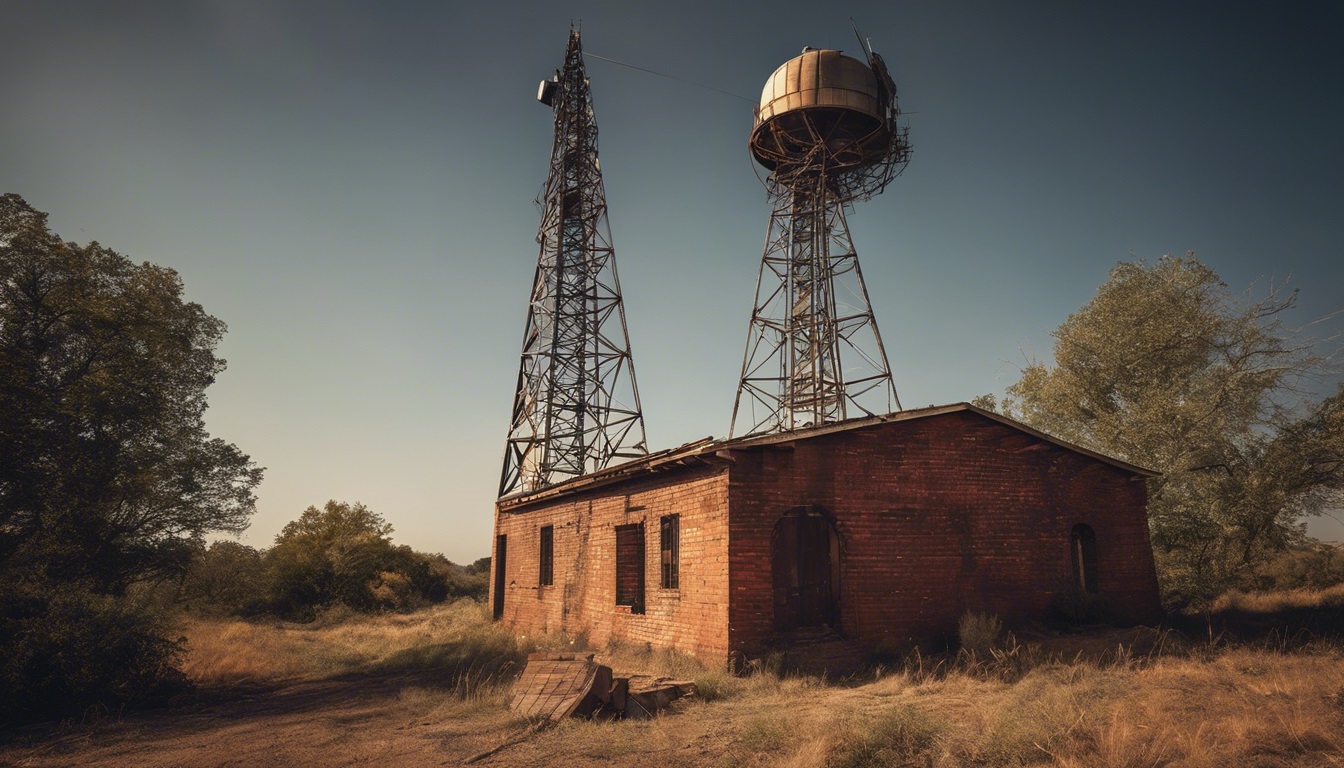
When prepping for disasters or SHTF events, your ability to communicate can be just as critical as food and water supplies. Let’s get into how you can establish a robust communications strategy.
Establishing a Communications Plan
You’ll need a solid communications plan. First things first, identify your key contacts—these are the people you absolutely need to stay in touch with during a crisis. Next, decide on a primary channel, like a cell phone, and a backup, such as a hand-crank radio. Don’t forget to establish clear protocols for when and how often to check in.
- Key Contacts Table
Contact Primary Channel Backup Channel Check-in Times Family Cell Phone Ham Radio Twice a day Friends Internet (VOIP) Satellite Phone Once a day Neighbors Handheld Radio Landlines As needed
Using Radios and Alternative Communication Tools
Radios can be your lifeline, especially when modern tech fails. A ham radio is invaluable for long-range comms, but you’ll need a license to operate one legally. For shorter distances, consider family band radios which are more user-friendly.
- Radio Options List
- CB Radio: Acronym for Citizens Band Radio, used for short-distance communication without a license.
- Ham Radio: Also known as amateur radio, covers long distances but requires a license.
- FRS/GMRS Radios: Family Radio Service (FRS) and General Mobile Radio Service (GMRS) radios are good for local comms.
In a pinch, don’t forget alternative tools like satellite phones for remote locations, or even the humble landline which often works when the grid is down. And remember, the internet can be a powerful communication tool if it’s still up—think social media, email, and VOIP services. Just maintain a plan for when the digital world goes dark.
Staying Informed and Educated
Being ready for any disaster means staying informed and constantly upgrading your knowledge base. You’ve got to keep your ear to the ground and your eyes on the prize, researching and training regularly while tapping into local and regional intel.
Conducting Regular Research and Training
You need to hit the books — and the web — to stay ahead. Regular research is your best buddy in understanding potential SHTF events you might face. But don’t just read up; put that knowledge to the test.
- Practice makes perfect: Conduct drills based on your research to solidify your skills. This could mean staging a mock bug-out scenario or practicing water purification methods.
- Stay updated: Subscribe to industry journals, online forums, and blogs that discuss survival tactics, gear updates, and the latest in prepper education.
Leveraging Local and Regional Information
Local knowledge is gold. It’s tailored to your environment, which affects the types of disasters you may encounter.
- Network with local authorities: Get in touch with your local civil defense or disaster management agencies. They offer insights and training specific to your region’s risks.
- Attend community meetings: They’re great spots to swap info on potential threats and share knowledge.
Frequently Asked Questions
In this section, you’ll find practical answers to help you prepare effectively for a variety of SHTF events, focusing on what to include in your kit, cost considerations, and the key steps to crafting your survival strategy.
What should be included in a solid SHTF survival kit?
Your survival kit should have water, non-perishable food, first aid supplies, tools like a multitool and flashlight, and personal hygiene items. It’s also wise to include emergency blankets and a means to start a fire.
How does one create an effective SHTF plan during uncertain times?
Start by assessing potential risks in your area, then outline procedures for each scenario. Gather supplies, establish communication plans, and rehearse your plan regularly to ensure you remain prepared for abrupt changes or emergencies.
What’s the estimated cost to fully stock a prepper’s survival cache?
The cost can vary widely, starting from a few hundred to several thousand dollars, depending on how extensive your supplies are. Essential items command a baseline investment, but costs escalate if you opt for advanced gear or longer-term supplies.
Can you explain the key differences between preppers and survivalists?
Preppers often focus on preparing for specific disasters and ensuring comfort during emergencies, while survivalists prioritize adaptability, self-sufficiency, and surviving with minimal resources under harsh conditions.
What are the top priorities when prepping for major emergencies?
Secure your water supply first, as it’s crucial for survival. Then focus on food storage, followed by shelter and safety measures. Health supplies and communication methods are also high-priority items.
What areas should a beginner prepper focus on first?
If you’re just starting out, concentrate on the basics: water storage, non-perishable food supplies, a reliable first aid kit, and ensuring you have a safe, accessible place to hunker down during a disaster.

Leave a Reply